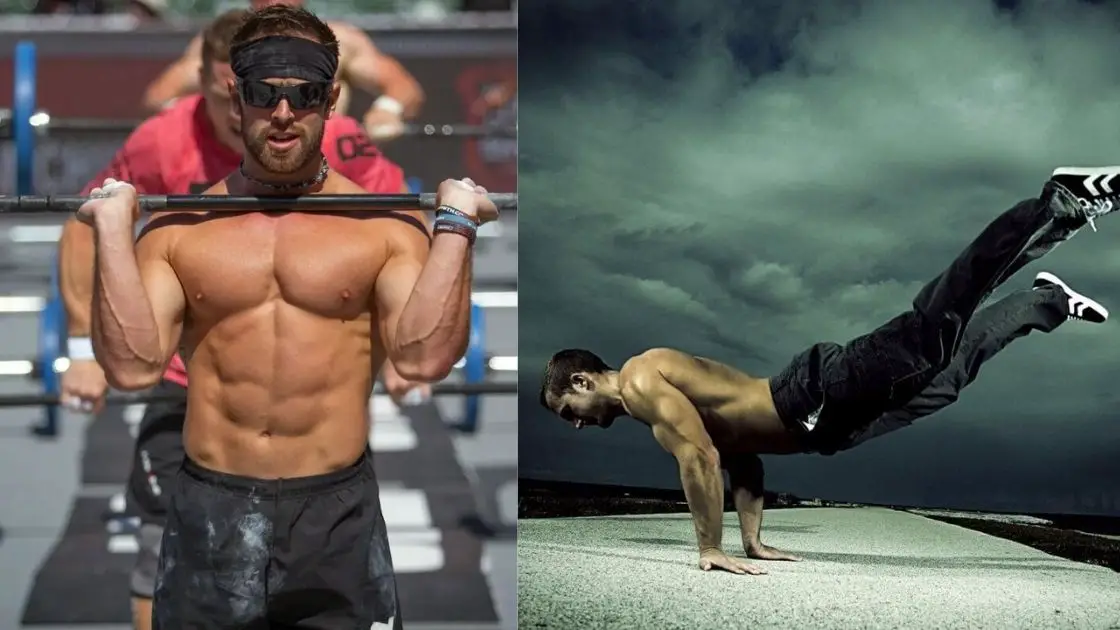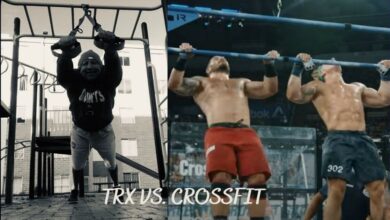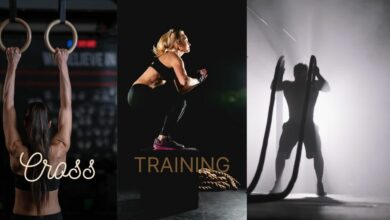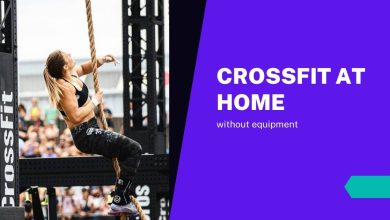For people who desire to live an active lifestyle, deciding on the best fitness plan is always a challenge. So, we are about to make this challenge easier by comparing Crossfit vs calisthenics and giving a guideline for it.
The initial step for solving this puzzle lies in understanding our expectations. We can start by answering questions such as: what do we want from a fitness plan? What are our expectations of it? What are facilities and space requirements? How much time do we have?
The route we take determines the result we get. Appropriate evaluation of needs and desires helps us make realistic decisions and avoid wasting time and financial means.
Table of Contents
Difference Between Crossfit and Calisthenics in Definition
Contemplating on terminology, we will get some hints as to Crossfit vs. calisthenics. Calisthenics originates from Greek. It is composed of two words, “Kalos” which means beauty, and “Stenos” that is strength. It simply indicates that body beauty is a core ingredient in calisthenics methodology.
Crossfit is composed of cross + fit. The composition indicates that it varies across different aspects of fitness. In other words, the focal point of Crossfit is athleticism and functionality.
Calisthenics vs Crossfit Body Shape
Calisthenics uses the body for the benefit of the body. Range of motion, angle of pressure, and all activities are aligned with feeling and performing better in the body. A study in 2017 on the effect of calisthenics on body composition, posture and strength concluded that calisthenics is an effective solution to improve posture, strength and burn calories without apparatuses.
To put calisthenics vs Crossfit body shape into perspective, we can compare the physique of a pro Crossfitter vs calisthenics trainee and the noticeable difference in skeletal structure. Handling external stressors moves the focus of pressure away from the core. The musculoskeletal system requires a different coordination to maintain balance while controlling an external object. Meanwhile, the skeletal structure has to develop to bear more weight than body weight.
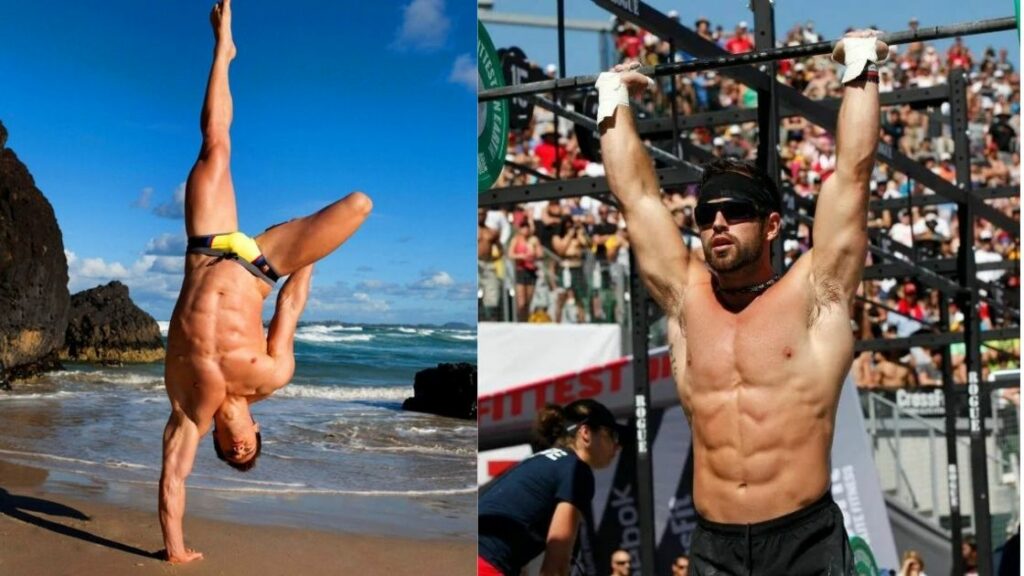
Does CrossFit Change Your Body?
Crossfit body shape reflects the type of exercises they perform. Crossfit puts emphasis on functionality, weight-bearing, and performance fitness. These exercises are not designed to sculpt the body to its best look. In similar fashion, a bodybuilder is not trying to look attractive on the beach.
Apart from technical differences in Crossfit vs. calisthenics, we shall not neglect the role of nutrition, genetic disposition, age, and gender in the formation of body composition.
Everything Does not Boil Down to Exercise!
The term “fitness” applies to many areas of functionality, performance, body shape, etc. Sometimes functional fitness and aesthetic fitness correspond, and sometimes they don’t! Some say that Crossfitters look boxy! but we also see the Crossfit women’s body to be curvy and well-shaped.
Beauty Is in the EYE of the Beholder
Read about: Calisthenics body vs weightlifting body.
Calisthenics vs Crossfit for Beginners
Crossfit maps out its training programs with scalability in mind. You can start at any stage and gradually grow into it.
According to the Crossfit website:
CrossFit program is designed for universal scalability making it the perfect application for any committed individual regardless of experience. We’ve used our same routines for elderly individuals with heart disease and cage fighters. We scale load and intensity; we don’t change programs.
However, Crossfit is competitive by nature. The program is not designed to be gentle and relaxing. You have to constantly challenge your limitations, and it is notorious for injury risk. Talking about the risk of injury, advanced bodyweight exercises had better be under the supervision of a coach to prevent injuries. Instability is the nature of bodyweight moves, which increases the possibility of injury in beginners.
Further reading about Crossfit injury: Crossfit muscle pain.
Calisthenics, on the other hand, is more versatile. You can easily shift gear from calisthenics to cardiovascular mode for health and freshness. There is no age limit. Even a simple jog in the park is a body weight type of exercise. Alternatively, you can scale it to a more professional type, such as bodyweight hypertrophy with TRX to build muscle mass.
The only drawback or maybe advantage (depends on how you look at it) is that there is no clear calisthenics roadmap for beginners to follow. Calisthenics progression requires the trainee to have some fitness knowledge or follow the guidelines of a trainer. It’s an advantage because it allows endless possibilities for training plans.
Please note that some of the links on this website are affiliate links, which means that we may earn a commission if you click on the link and make a purchase. This won’t cost you anything extra.
What equipment do you need to start CrossFit at home?
You’ll need an Olympic weight lifting bar with some plates and some free weights to set up your home CrossFit gym. E.g., dumbbells or kettlebells, barbell, power rack, and a pull-up bar. However, this is for a traditional Crossfit exercise. We can also have more dedicated Crossfit workouts without equipment or add a few bodyweight apparatuses such as TRX. Anyhow, the traditional Crossfit training plans involve both bodyweight and equipment-based exercises.
Does Calisthenics Require Equipment?
Calisthenics is a type of exercise that requires little to no equipment. A set of TRX bands, rubber bands, a yoga mat will do the work, or you even use none and just rely on your body to build strength and muscle.
Crossfit for Cardio
Cardiovascular exercises such as running, climbing, and swimming are known for their cardiorespiratory benefits. Cardio increases heart rate, and thus blood circulation system and lungs are put to work.
Experiments with Crossfit show that it has cardiorespiratory benefits without being particularly a cardio exercise. For that experiment, a group of Crossfitter and a group who practiced rowing wore heart-rate monitors.
The Crossfit group practiced 20 minutes AMRAP (as many reps as possible), including:
- 5 pull-ups
- 5 push-ups
- 15 squats
For 26 rounds
The cardio group rowed 5,403 meters in 20 minutes.
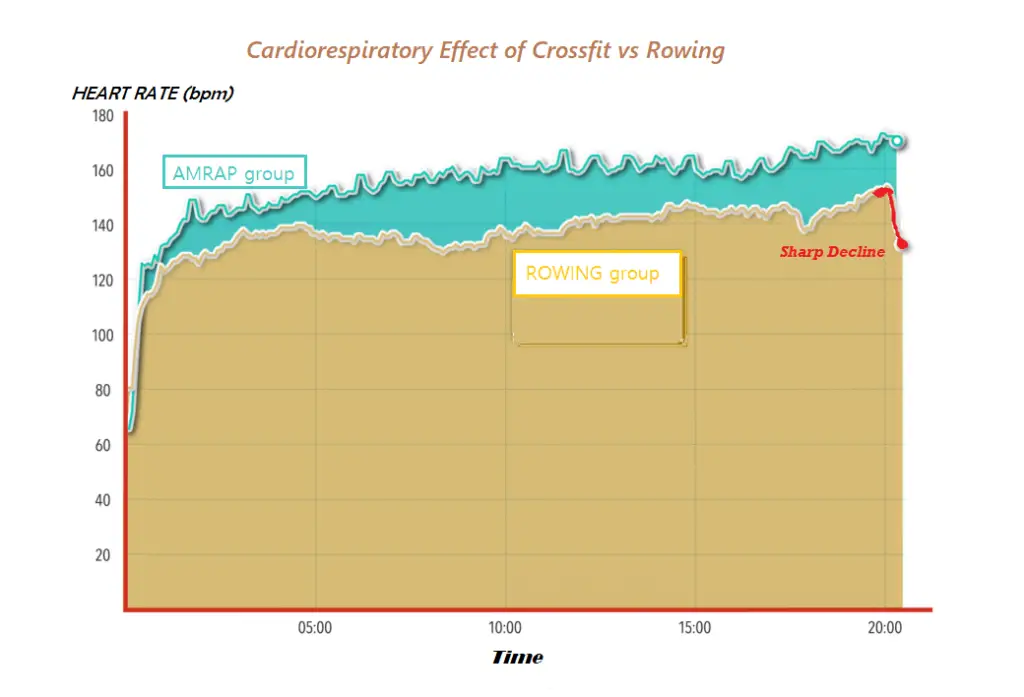
According to the results chart, the AMRAP group registered a noticeably higher heart rate compared to the row group. Apart from that, after finishing the 20 minutes of exercise, the rowing group experienced a sharp decline in heart rate, whereas the Crossfit group had a slow decline. This indicates that the AMRAP group were continuing to have a high heart rate for an extended period of time after 20 minutes.
In this experiment, we can see that although pull-ups, push-ups, and squats belong to the strength training system, in the ecosystem of Crossfit, they provide potent cardiorespiratory stimulus; in fact, more effective than mono structural cardiovascular exercises.
Some people who were runners and then made a shift to Crossfit also had similar experiences. They said they could preserve their running ability by running less within Crossfit protocols. Besides, the lung and other cardiorespiratory advantages they gained were not limited to merely running because Crossfit is not restricted to one domain of activity.
Calisthenics for Cardio
The goal in cardio is to increase heart rate. Most well-known cardio activities do not require equipment because they need low resistance. For that reason, body weight protocols are long known trends for cardiovascular fitness.
The above experiment about Crossfit for cardio shows that Crossfit is the winner in increasing heart rate. Nevertheless, that experiment was between Crossfit and simple mono-structural cardio and not Crossfit vs. calisthenics. It was long-distance rowing vs. AMRAP. Cardiovascular training can be in the form of HIIT as well, which produces different results. In effect, HIIT is the winner in Crossfit vs HIIT for weight loss.
Hence, we cannot generalize the above experiment to calisthenics vs CrossFit. Calisthenics comprises many different training protocols, with strength being the core part. We may as well try Crossfit bodyweight WOD, which combines Crossfit and calisthenics.
The border between training systems is indistinct. Any improvement in a specific fitness zone affects other fitness metrics as well. Accordingly, calisthenics as a strength-based protocol will affect cardiovascular fitness. All the same, a strength-based protocol cannot replace an aerobic training plan for that purpose. Hence, a combinatory method ensures the best of both worlds.
What is Conditioning in Fitness?
The words “strength and conditioning” usually come together. Conditioning refers to the process of preparing your body to perform its best in its actual strength, aerobic fitness, or flexibility exercise.
Cross-training exercises are ideal for conditioning. For example, in order to make progress in the squat, you may perform other activities that put you in better condition for squatting. You may practice sprinting to enhance fast glycolytic fibers in leg muscles, or do depth jump to improve turnover.
Conditioning in Crossfit
To make progress in Crossfit, you need a proper foundation in both aerobic and anaerobic systems. Even flexibility plays a role in many activities.
- Anaerobic conditioning, also known as Crossfit metabolic conditioning, helps with high-intensity exercises that last less than two minutes.
- Aerobic conditioning is helpful for cardiovascular activities that take longer and require high oxygen intake.
Depending on the fitness condition of each individual, each of them may be prescribed for Crossfitters. You will need to maintain a balance between the two to cover your weaknesses and make progress.
Is CrossFit Good for Conditioning?
When we talk about conditioning for other sports, such as Crossfit for MMA conditioning, the answer would be negative unless the program is specifically designed for that. Other sports require sport-specific training tailored for that activity. Crossfit training is across various domains, and it gives mixed signals to the body for adaptation.
The output of this multi-domain adaptation is not optimized for a specific sport like MMA fighters. However, there are also sports-specific Crossfit strength and conditioning programs for football and other sports.
Calisthenics for Conditioning
Almost all calisthenics exercises are types of conditioning exercises as well, but that again depends on your goal and your specific sport. For example, mastering the pistol squat will improve balance and coordination, aside from strengthening hamstrings. Bodyweight exercises are also suitable for aerobic conditioning programs.
What is Body Weight Conditioning?
Based on the definition, bodyweight conditioning refers to the general improvement of fitness through body weight exercises. It can include strength, tone, or aerobic capacity. Through this phase of training, you become prepared for more advanced body weight exercises. It’s possible that bodyweight conditioning isn’t a full-body conditioning program if it’s customized to help with a certain sport. The same concept as in conditioning with weight applies to bodyweight conditioning.
Crossfit Fitness vs Calisthenics Fitness
The Crossfit fitness pyramid illustrates the approach of Crossfit vs. calisthenics in fitness.
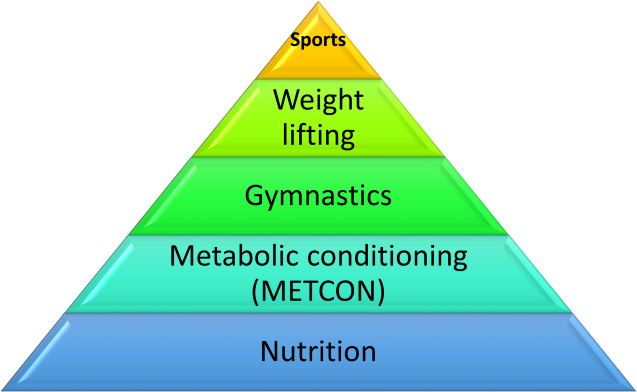
The foundation of Crossfit fitness is nutrition. It goes without saying that nutrition is the basis of health and fitness, including but not limited to body weight protocols.
METCON or metabolic conditioning points to cardiovascular sufficiency. Crossfit ideology is that cardiovascular capacity is fundamental in athletic development. So, before weight or resistance, an athlete should build a suitable cardio foundation. Metabolic conditioning is similar to circuit training, in the sense that the athlete moves from one activity to the next with little recovery in between. The only difference between METCON and full-body circuit training is that Crossfit can also use weights.
Further study: Crossfit vs circuit training.
Gymnastics highlights spacial awareness and body control in different positions. Gymnastics comes before weight lifting. It denotes that flexibility, coordination, and balance are more important than lifting external objects or coping with opponents. Gymnastics itself is a body weight regimen. Only Calisthenics is more advanced in this and comprises all different body weight protocols, including TRX.
Weight lifting is on the fourth level of the Crossfit fitness pyramid. Once athletic performance in gymnastics and METCON reaches a certain level, it is time to handle external weights. These skills can be refined for sports-specific training programs. This is where calisthenics probably falls behind. Calisthenics is not designed to carry external weight and control objects while keeping balance.
Once you have worked your way up to the top, training for sport joins your weekly routine. This is the stage where you enhance sport-related physical attributes, and your body will tolerate new stressors. To reach your maximum capacity in sport, your weight lifting, gymnastic and METCON should be up to par. Athletes should practice new sports regularly to hone their skill set.
The purpose of Crossfit is to develop a full-fledged athlete, while bodyweight training is not that ambitious. It is acceptable as long as a person can manage his own weight and stay fit.
CrossFit vs Calisthenics for Fat Loss
Calisthenics uses body weight to create resistance. The scope of calisthenics is around the isometric and strength range, with movements such as push-up, pull-up, and muscle up. This means that we can differentiate cardio from calisthenics. Putting calisthenics in the category of resistance training means we shall not expect the fat-burning rate of cardiovascular activities from it. Nevertheless, full body calisthenics burns more calories than split workout.
Crossfit includes metabolic conditioning (METCON), which emphasizes cardiovascular sufficiency. METCON is anticipated to be an efficient fat-burning system, but it is just a part of the Crossfit fitness pyramid. Its role is to establish a proper cardiovascular foundation. It can be an effective fat-burning strategy if used in conjunction with a proper diet plan.
After all, diet is the prime component of weight loss. Some people stated that a combination of Crossfit and Paleo diet was enough for them to lose some extra weight. In comparison, the keto diet seems to be unsuitable for a Crossfitter or any athlete that requires daily intake of carbs.
Both Crossfit and calisthenics burn calorie, but your intake and fitness goal play the main role in the result. Sometimes it makes sense to bring an exclusive aerobic program into the scheme, especially if you are overweight. Apart from that, from time to time we may slightly gain weight in our systematic training. In that case, minor adjustments in the diet plan will bring about the desired outcome.
METCON vs Calisthenics
METCON is a cardiovascular training regimen. Rather than being a steady exercise, such as running, recumbent bike, or treadmill, metabolic conditioning takes the route of interval training. It is a dynamic exercise and follows the mindset of “constantly varied” in Crossfit.
METCON can consist of bodyweight exercises, kettlebells, dumbbells, or sprinting. It’s a hybrid training mode, but it does not cross into the domain of strength training, which is where calisthenics occurs.
METCON includes both high-intensity as well as moderate-intensity interval training, whereas HIIT is always about high-intensity interval training.
Crossfit vs Gym vs Calisthenics
Bodybuilding is the way to go for those who opt for bulk. In comparison to Crossfit and calisthenics, bodybuilding lacks functionality. Body weight exercises are more minor, and it does not encourage aerobics unless for warm-up or cool-down.
Compared to Crossfit, natural bodybuilding has a lower risk of injury. Sometimes we can see people in their 60s are still lifting weight, but this is a rare scene in CrossFit.
With calisthenics, you cannot develop the strength and muscle size of a bodybuilder. After a certain level, you will need weights to make progress in mass building. Calisthenics is not the best option for building lower body muscles. We require more than body weight for that, which means the gym is more effective in that regard.
Crossfit, gym, and calisthenics demonstrate significantly different body compositions. If you are not making every effort to compete in any of these, it’s best to choose the one you enjoy the most. Interest is a great motivation for a lifelong athletic lifestyle.
Also study: CrossFit vs. Gym: Which Training Discipline?
Crossfit vs Bodybuilding vs Powerlifting vs Calisthenics
Powerlifting revolves around three main moves: bench press, squat, and deadlift. The objective is to lift as much weight as possible off the ground. For this purpose, powerlifters also train in other parts of the body to make the entire system integrated and optimized for the big lift.
In powerlifting aesthetics, functionality, and flexibility are not as important as in the other three. The difference between bodybuilding vs. powerlifting amounts to muscle mass vs. strength. Bodybuilding does not prioritize strength, although they definitely gain strength. Crossfit defines a person as fit if they are fit in each of the 10 physical attributes: strength, stamina, endurance, cardiovascular, flexibility, power, agility, balance, coordination, and accuracy.
Injury Risk of Calisthenics vs Crossfit
Because calisthenics employs very little equipment and weight, the injury rate is very low. On the contrary, Crossfit is known for its high rate of injury. The competitive nature of Crossfit, which is demonstrated in Crossfit games, along with “constantly varied” mode of exercises increase the chance of injury.
Is Calisthenics Harder than CrossFit?
Both strategies require you to push your limitations. That’s the only way you can improve your athletic metrics. There is no shortcut for that. So, we cannot say that one is harder than another. It all depends on the training program and your exercise strategy. However, based on the explanations above, calisthenics is probably more beginner-friendly. People at any age can try it without any limit whatsoever.
To Sum up Crossfit vs. Calisthenics
- Calisthenics differs from Crossfit in the sense that calisthenics exercises are without apparatus, whereas Crossfit comprises both apparatus and no apparatus modes.
- Crossfit involves both aerobic and anaerobic training modes, but metabolic conditioning is set prior to weight lifting.
- Calisthenics is a strength-focused body weight training strategy. Cardio activity is another protocol in body weight training style. A training plan based on calisthenics can add cardio to form an all-around exercise regimen.
